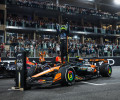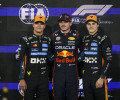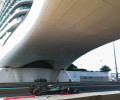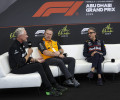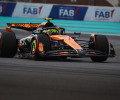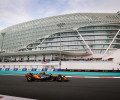FIA Press Conference Transcript
FIA REPRESENTATIVES – Charlie WHITING (Formula 1 Race Director), Nikolas TOMBAZIS (Formula 1 Head of Technical Matters)
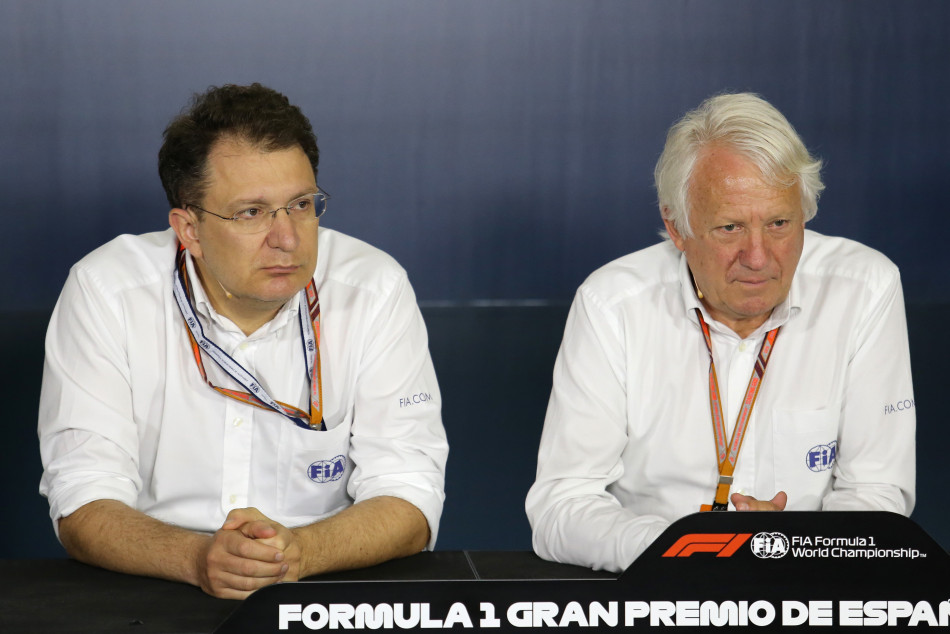
Q: (Mark Hughes – Motorsport Magazine) Nik, we’ve heard an outline of the 2019 aero regs, when will know a bit more detail in terms of dimensions and geometries and things like that?
Nikolas TOMBAZIS: Well, the dimensions have already been put down in a detailed wording. What was actually voted in the e-vote was a detailed wording. Now, what we have on Sunday is a discussion with the teams in order to make sure that we cover any little loopholes or any little open points there may be. Not in order to again put down whether we want it or not or the particular substance but rather the detail. I should think that after that discussion on Sunday then we will be able to make official the rule wording in detail. But the substance is already clear, the dimensions and everything.
Q: (Christian Menath – Motorsport-Magazin.com) We all know that these changes are done for improving overtaking in Formula 1, but I guess you also did some simulations on how the general car performance is affected by that? Will it be the same as we have now, the one-lap performance of the cars or is it better or worse?
NT: We expect this rule change to be approximately halfway or one third of the way less performance of the delta between ’16 and ’17, so we expect to lose about 1.5s, that sort of order, but it’s a bit difficult to predict exactly the amount of development the teams will put on but we certainly expect to lose performance – that order or magnitude.
Q: (Livio Oricchio – GloboEsporte.com) These new rules will increase the effect of the DRS. How will it work on a straight like here for example? Can you give some practical example how it would help overtaking, as we see it now?
NT: Sorry, there are two parts of the question, one is purely aerodynamic, technical and one is maybe more to do with the implementation. I’ll answer the first one and leave Charlie to do the second. The DRS effect, as you say, will increase, by approximately 25-30% - that is the delta of the drag of the car when it opens the DRS, when it deploys it to current will be bigger, so the delta of speed of the following car will as a result be bigger by that amount. Hence, the probability that he can then approach the front car will increase. That then leads to Charlie on how DRS zones will be affected and implementation.
Charlie WHITING: I think the main advantage to us will be that we will be able to make the DRS more effective on shorter straights. At the moment we’re trying to lengthen zones where we can, in places like Melbourne for example, maybe an extra DRS zone in Canada. Those are the sorts of places that with the extra power from the DRS we should be able to make them work a bit better.
Q: (Dieter Rencken – Racing Lines) The current aero regulation change for next year, is that part of a building block for the post-2020 regulations or how do the two sets plug into each other?
NT: As you all know, there is work going ahead at Formula 1, with the collaboration of the FIA, for 2021, and this work is still ongoing and covers a lot of more complicated areas of the car, which need, frankly, quite a lot more work before we can define a regulation. These regulations for ’19 were an extract of some of the lessons learned already at Formula 1. They obviously had to be implementable for ’19 and therefore they only covered specific areas of the car that are a bit more simple. The underlying lessons that we have learned, with F1, about how cars perform in the wake of other cars etc have been used, but let’s say it’s only a halfway house and so on. I don’t want it to be confused with the work that is going on for ’21 in the future that is going to be more extensive and will have much more time for research and so on.
Q: (Ted Kravitz – Sky Sports) Charlie and Nik, when DRS was first brought in there were fears about it making the racing artificial. As it’s turned out, it hasn’t been too bad on that front. Yet, people are still a bit wary of it. Ross Brawn himself says it’s one of the things about F1 he doesn’t like. Do any of your studies suggest that increasing the effect of it by 25% - it sounds like quite a high number – might be getting towards a place where it’s too easy to overtake or very artificial?
CW: I think we would continue to tune it in the way we do now. I’m not sure if I’ve mentioned this before but what we do is look at how effective the DRS is at each circuit and then we try to tune it in order that you have to be within four tenths of the car in front to make it work. Now that four tenths is quite a difficult gap to get to but if you can get to that and you’ve got the length of straight, you should be alongside by the time you get to the braking point. That’s how we do it now, but if we can do that with shorter straights it’s going to work on more tracks. It won’t be any more effective, in that sense, if we tune it the same way. Even though it does have increased power, we’ll be able to use it in more places. But we don’t necessarily want to make overtaking on a given circuit easier, we still want a driver to work for it.
NT: I would add that at some circuits where overtaking is already considered satisfactory or let’s say easy enough or whatever, the solution could be to decrease the DRS zone for example, whereas at a circuit like Barcelona where overtaking is never easy, I think having that extra power may just about make it possible.
CW: It could even work on the back straight here for example. I’m not saying it will, but with the extra power it might be a bit more effective on that sort of straight.
NT: I would also add that it is right that there is underlying discomfort with DRS and I share it as well. I know Ross has made similar comments and so on. We feel DRS is the right thing to have in the present state of things. For 2021 we hope that the cars will be much more able to follow each other closely and it would be a really nice outcome if we can severely decrease DRS in the future or even eliminate it. But until we get in a position where we are comfortable enough with the wake performance and how cars can follow each other I think it’s something that is… I would call a necessary evil perhaps at the moment.
Q: (Livio Oricchio – GloboEsporte.com) Nikolas, we have been seeing the front wing extremely well develops – three four levels of flaps. Do you think changing only the end plates of it you will be successful in keeping a car closer. Is it realistic to believe for example here one car in Turn 3 very close to another one?
NT: First of all, it’s not a matter of either black or white – either you can follow or you can’t. We hope to make an improvement in close racing and to be able to follow more closely. The change of the wings for next year is not just the end plate, the end plate is significantly simplified, but all the top furniture – the little winglets that you can see, the various vertical fins and so on, which produce a range of vortices which are intended to control the front wheel wake – these are getting eliminated, and the wing profiles themselves have to follow certain rules which make them let’s say simpler and hence less able to control the wheel wake. So, in our studies, then, that wheel wake is then what affects the rear car and losing control of that, we feel, is going to make a step improvement. But as I say, I’m not expecting cars to be bumping each other like touring cars. It is just making a step forward. I would also add that the way development is going in current racing, one of the key tasks of aerodynamicists in a Formula 1 team is to move the wheel wake further outboard for the benefit of their own car. The more outboard it is the less it affects the diffuser or the rear wing and they gain performance. So that is their key objective. That key objective is also bad for the following car. So our expectation is that if we didn’t do a rule change the next two years, ’19 and ’20, would be gradually getting worse. So part of the rule change was also to stop that trend and make a step change. We feel that these performance characteristics would have actually been worse for ’19 and ’20 if we did nothing.
Q: (Joe van Burik – Autocar.nl) Guenther Steiner just expressed his worries for the proposed changes. He fears it might not have the desired effect, maybe even an opposite effect. How will you ensure this doesn’t happen? With any real live track tests?
NT: Well, we need to freeze the rules and people need to design their cars. We’ll only really know how well we’ve achieved that aim next March or April. We’ll be able to follow teams’ development before that but we won’t really have any proper results. Any rule change has a degree of risk and these are no exception in that regard. We cannot be completely certain of every single thing teams will do in developing. What we have tried to do for these rules is to have a much more careful wording on some areas of the car to try to avoid any particular loopholes or any completely different directions that teams could take. And I think the probability that we will make it better is very good. The probability that we will make it better but not by a huge amount is also there. I think the probability that it actually makes it worse is, close to zero, if not zero, in my view. But clearly people who maybe haven’t seen the data as much as we have can express their doubts and worries, that is understandable.
Q: (Michael Schmidt – Auto Motor und Sport) Drivers who follow another car report that they are feeling the wake when they two to three seconds away already. With the new rules how much will you able to minimise that effect?
NT: The wake performance is obviously something that is… the effect is huge when you are half a second behind, in reality it is the distance that matters. not the delta time, so you know, when you are on the straight the distances are bigger. When you are one second it is yet another bit worse, and say 20m you already have a significant effect, 40m it’s beginning to be a bit smaller. We feel that there is an improvement on all of these by a certain percentage. So it will mean in real terms if a car with the ’18 rules could follow within a second the front car, if it’s got a certain pace advantage, this we expect will just become a bit smaller and he will be able to follow to 0.8s or something like that. So effectively, for the equal amount of performance lost, he will be able to follow a bit closer.
Q: (Edd Straw – Autosport) In terms of quantifying the improvement in a bit more detail, have you done some simulations work in how much more overtaking that might have created in sample races this year for example? I remember when we had the overtaking working group the target was set at a lap time delta of two seconds, it was at that stage needed for a clean pass, and the regs aimed to bring that down to a second. Is there any more detail in terms of the impact it will have. It’s clear there will be some benefit but can you be precise and really quantify that?
NT: I’m afraid not. I can’t give you an exact number. We know from the work that Formula 1 is doing, we have targets for 2021. This is certainly a significant step, we feel, in the right direction but to give you an exact number I’m afraid I can’t, no. I wish I could but we didn't have all the full simulation time and all of that available.
Q: (Ian Parkes – New York Times) Can you go into detail about the level of research that was conducted before this regulation change came in, how long it’s been ongoing?
NT: First of all, I would say that with the exception of 2009, while the time has been very short, the level of research is more than virtually any other regulation change in aerodynamics that has taken place. I know one of the criticisms is the amount of time available but I would say there has been quite a lot of work done. What we used for our initial proposals was the feedback from the Formula 1 work, as I mentioned previously. That has been going on for about a year and we have learned certain lessons there. So that feedback was formed the basis of the proposals we made to the teams in early April at the Bahrain Grand Prix. We had a meeting there with the teams and they were expressing a lot of worries about these rules not having enough research and so on. So we invited the teams to do a certain amount of simulation themselves. Most teams participated in this initiative and we are very grateful for their work so each team sent a report to us around approximately the 26th of April or something like that. Then we collated all of that research into a single report that we submitted to the teams, to the Strategy Group, the F1 Commission and the World Motor Sport Council. Clearly all teams did different things a bit, because there was a limited amount of time. So results ranged from small benefit to big benefit. There was no result that showed a worsening of any characteristic. There were reasons why some people were reporting smaller benefits and some bigger and we tried to use common sense in trying to collate all of that and that was what was written into the detailed report that was sent to everybody who voted.
Q: (Tobias Grüner – Auto Motor und Sport) With the front wing much simpler and the freedom of development restricted, do you expect the cars to get closer together in terms of overall performance, from top to bottom?
NT: That is a debatable point. I feel that the answer is yes, but some people will perhaps say no. I believe that as teams have to reset their performance before starting there 2019 research, they are starting from closer to each other and I think the number of a degrees of freedom on the front wing are fewer than on the current rules, hence I expect the delta of performance to be a bit smaller. There are certainly going to be some people who get it wrong and maybe don’t manage to understand the opportunities the rules give properly, so there maybe the odd person or odd team that gets it wrong. I think overall I expect there to be a slightly smaller differential.
Q: (Christian Menath – Motorsport-Magazin.com) Question for Charlie. The procedure with the DRS we have at the moment. That will stay the same with 1 second delta to the other car. Did you think about that as well? To change it like we had in World Series, I guess a few years ago, or DTM, that you have DRS also available for defending yourself, to make it a bit more fair – because we’ve had the discussion earlier with the artificial thing of DRS.
CW: I don’t think so. It’s not the way we want the DRS to work. I know there is divided opinion on whether we should even have the DRS but I think it’s worked very well for us. I think it’s fulfilled a need but I don’t understand why we would want to give anyone the opportunity to defend themselves. It would defeat the object, I think – but that’s only my opinion. I think it’s always how it’s worked. Because it’s not easy to get within the distance required to actually make a pass, we’ve seen it time and time again, it really is not easy. It sometimes looks easy – but that’s when there’s an inherent performance difference between the cars. If you’ve got cars of equal performance, which you have to base it on in the beginning, then I think the driver has to work quite hard to get past another car. So, for me, it should remain exactly as it is.
Q: (Dieter Rencken – Racing Lines) Nik, you’ve a few times referred to the work that Formula One has done, as you termed it. How would you best describe the relationship between Formula 1 – or FOM – and the FIA now, with regard to the post-2020 regulations. Are they acting as consultants, will they just provide a rulebook for the FIA to rubberstamp? How will the entire procedure work?
NT: Well, I should point out they have a team of aerodynamicists doing work and research. I was, before joining the FIA, was working… I was consulting for them directly. So I was there on a frequent basis and discussing their results, and after joining the FIA my relationship and the FIA’s relationship with them in general is continuing. So we have… I don’t think it is correct to put any real boundaries there because they have provided this research resource, let’s say, and we all have the same interest. They have the same interest as we as the FIA have the same interest in what we want to improve so there’s no, what you call it, conflict over who rubber stamps it. Work is following scientific and engineering principals and it’s researching what’s important. The FIA will then eventually write the rules in the end, so it’s not Formula 1 but I think it is really not correct to put a boundary there because it’s a team effort and they’re doing a lot of good work and we are participating in that.
Q: (Olav - Ziggo) Charlie, are you also going to change the way it’s scrutineered – because I feel everything you do with the car, that car is stationary and it’s all legal – but once it’s down the straight full speed there’s no limits left. Everything bows out and goes down. I know you test it with weights and stuff like that – but are you going to do some digital scrutineering on that as well to check what’s happening? Because if would put a simple piece of tape on a television you could see how much the wing defects. You just could measure it.
CW: Well, we’ve always gone down the route of having load deflection tests…
Stationary?
CW: …of course. It would be a little difficult to do it in any other way. But that’s always stood us in reasonable stead. We have an overarching rule which allows us to impose any new load-deflection tests without notice if we feel something is being done incorrectly – but generally speaking I think we tend to be always playing catch-up to some extent because teams obviously know exactly what the limits are and work to those limits. They’re frequently being checked and they adhere to those limits but every now and then you find a new area of interesting – shall we say – from the teams and then we have to look at that again. Overall I would say it’s OK and when you talk about DRS, we have the slot gap, and we always check the fully open and fully closed positions of that. So, we have to do them statically. As I say, it would be a challenge, I think, to do it in any other way.
NT: From my previous experience working on the other side of the fence in a Formula One team, I think the rules have advanced a lot since their first introductions in the last 1990s, or mid-1990s, and they have become really quite successful in many areas because the rules are very much mimicking the type of aerodynamic loading that happens on the real car. So, even though it is not perfect, I think the number of loopholes that a team can exploit has really decreased dramatically.
Q: (David Croft – Sky Sports F1) I’m going to throw this one out there because we’re talking about creating closer racing and more exciting racing for the future, and one of the ways to do that is to have the cars running a lot closer together in the race, as we’ve seen with Safety Cars recently as well. Backmarkers holding up cars that are about to lap them can often help make exciting races. Why do we need blue flags these days gentleman, and is there any talk to trying to remove them for the future to create more exciting racing?
CW: Yes, there’s been talk about that. It’s been proposed a few times. Hugely unpopular with teams and drivers, of course. It’s something that is on the agenda, so to speak. It’s not been rejected completely but it’s something we would have to look carefully at to make sure that it wasn’t overly-exploited. But I think the principle… there are many forms of racing in which they don’t have such a luxury – but it’s something that we are open to discuss, certainly.
What’s the likelihood in percentage terms Charlie, of it being accepted?
CW: Less than 50 per cent, I would say – but that’s just a figure. It’s not popular, as I say. I think it would be quite something to get that through – but I think we need to think it through carefully.
Q: (Michael Schmidt – Auto Motor und Sport) If you find out next year that you have overlooked something – or somebody finds a loophole which goes against what you want to achieve, do you have a backdoor to correct it then?
NT: Well, it’s clearly a very undesirable scenario, which has happened, of course, at times in the past. That’s exactly why we’re having the meeting with the teams on Sunday. Now, you may of course say that a team may have found something and not say it in the meeting – but we feel we are covering the rules in a lot of detail, and hopefully with experience of previous years we can avoid that before next year, ie from now, to avoid this scenario. If something happened we would probably have to wait until 2020 to fix that – but I think that is, in my view, quite a low probability.
Q: (Albert Fabrega - Moviestar-Fox) Where there other aero changes, proposals, that didn’t go through?
NT: There were two big packages of changes. One big and one small, rather. The one that went through regards the front wing, the front brake ducts and the rear wing. There was another one affecting, as a separate package, the barge boards. It was a much smaller change, comparatively. The reason we kept it in a separate package to be voted, is because we were sympathetic to the teams not being able to research it enough in the one month it was on the table, and therefore we felt it a bit… whereas we think still it was the right proposal, it would have gone in the right direction, we felt there would have been a lot of doubt by some people not being able to research it, so we left it was a separate rule and that was not accepted.
Q: (Dieter Rencken – Racing Lines) Change costs money, normally big money. Is there any chance we could have regulations going forward that were that stable we could have the same cars for two years or more?
CW: I think… we’ve had stable rules in the past but teams have always had new cars each year. I think the likelihood of a team wishing to carry a complete car over from one year to the next is very, very low indeed. Occasionally a team might carry a survival cell over but that’s really the extent of it. I think the teams honestly are going to be doing the aero research anyway. They’ve got only a limited amount of aero research they can do, as you know, and they’ll use whatever they can. I think the contention that it’s going to cost a fortune to make these changes is a little over-exaggerated.
NT: There are some small teams that are enthusiastically in favour of that rule change, in my view for good reason because some components will be quite a lot cheaper – for example the front wing will be a lot cheaper to produce. As Charlie said, the ATR, aerodynamic testing restrictions mean a big team can’t double their research from now until then. Clearly teams need to address their priorities between ’18 and ’19 and that will cause them some headaches for sure and there’s been criticism, if I’m honest, some teams, for example smaller teams, who wanted to carryover some of their rear wings for next year and they say they won’t be able to carry them over. And that is true, that will cost them some extra cost. We feel that the cost reduction in other areas outweighs some of the extras they will have to pay. It’s not all again and I think the overall improvements outweigh the disadvantage – but I agree it’s probably an exaggeration to say it’s going to be a huge cost increase.
Q: (Christian Menath – Motorsport-Magazin.com) You mentioned the 2021 car that you’re working on at the moment. Is the changes we see for next year, are they a hint how the 2021 cars will look or is it just because you came up with some ideas during your analysis and this is a small change you can do with these cars or is it a hint for the 2021 cars – or are they looking completely different?
NT: There’s no hint there. The only commonality is some of the flow features, so things you cannot see, which we learnt about and we tried to apply some stuff for 2019 – but there’s no relation in any visual cues or anything like that. And I think it would be fair to say that it would be wrong to pre-judge 2021 in any way from 2019 because it is completely fair to say 2021 is benefitting from a lot more time to research – so I think even if we learn something that is unexpected in ’19 it will be of benefit for 2021. I don’t think one can really see the things as a single project, let’s say.
Q: (Mike Doodson – Honorary) Nik, you’ve made a successful and rewarding career as an aerodynamicist but let’s face it, aerodynamics research represents a very high proportion of any F1 team’s budget, yet it’s surely an aspect of racing which is of least interest, certainly to spectators and even, dare I say it, to some journalists. Is there a practical way to limit the effect of research and the money spent on it, to improve the racing in the way perhaps that Indy Car has done with apparently very beneficial effects?
NT: Well I think a fundamental part of Formula One is that there are different manufacturers that enter. There’s a Mercedes, a Ferrari, a Red Bull. People want to see a fight as well as between drivers also between cars and big manufacturers, so we can’t follow a route where we make everything standard, for example. But we can make things a bit simpler and ’19 is a step towards that direction. And where the benefit of more research will perhaps be a bit lower. Therefore, the delta lap time between P1 and P20 will go down a bit. And 2021 will give us an extra step in that direction. On top of that, in terms of your financial considerations, budget and so on, there was a very successful set of rules – ATR – aerodynamic test restrictions. If these were not in place big teams would have three wind tunnels and each would be working with 500 people in each aero department. So we’ve managed to reduce it. We feel there’s also a next step that can be taken in that regard to reduce it even more. I think this initial intervention, ATR, has been quite a successful cost control in aerodynamics. And if you want to make aerodynamics interesting, I can spend some time with you.
Q: (Albert Fabrega – Moviestar Fox) Did you personally feel there was more interest from the entities or persons that has the right to vote in the F1 Commission to know the details of this changes than previous or others in the past?
NT: I think it is fair to say we made the proposals at very short notice, and before people decide to commit to something like that, they understandable want to know why we’re doing it. Part of the task we had during April was to gather enough data from the team’s research in order to make a case. And frankly, the way the F1 Commission votes, if people thought it was a really bad idea, I think frankly we wouldn’t be sitting here now, they would have voted against it. It had teams, of course, voting against it, for tactical or technical reasons, and quite a few voting in favour as well.
Q: (Roksana Cwik - Swiatwyscigow) I would like to ask about Halo and the mirrors and other elements which are mounted on it. Are you not afraid that some of them can fall off on the track, with more debris, or hit someone?
CW: I think if anything… we’ve allowed them to be mounted from the Halo for practical reasons and we think it might even give the drivers a better view. As with anything on the car that’s fitted to the car, if we think it could result in debris being left on the track than we would stop it. We are acutely aware of the difficulties we face, especially in races like Baku where debris can’t go off the track, for example, and it seems like the slightest contact between cars results in debris on the track. This is something that we’re actively trying to improve on. So, as I say, if we see anything that we’re not happy with, then we will take action to stop it.
Q: (Livio Oricchio – Globoesporte.com) To Charlie Whiting. Most of the discussions we have in Formula One, even the fans, are related to overtaking manoeuvres. This project you’re presenting is to increase the overtakes. Do you think we will need an extension of the regulations concerning overtakes to specify more what is permitted, what is not permitted? Give an example of last race what happened between Max and Ricciardo. Most of the discussions of the grand prix are related to this behaviour.
CW: I don’t think there’s a need for different regulations, no. I sincerely hope that the regulation changes – and I’m optimistic that the regulation changes – will improve the likelihood of overtaking and I think it will increase the chance of a driver being able to follow another more closely. But, I can’t think of any reason why we need to change the existing rules governing overtaking. We have very clear rules I believe, about changes of direction and we have an overarching rule in the sporting regulations which, more or less, says anything deemed dangerous by the stewards will be acted upon. So, it could be used for everything. Two years ago we took out a lot of the detailed rules to just have one simple rule in there about dangerous driving, basically, and that’s the rule that’s used most of the time, in addition to the sort of things that drivers are allowed to do, like changing direction more than once in order to defend a position. I don’t think we need to elaborate on that. I think we’ve – successfully, I believe – got away from too much detail and now rely on a simple regulation.
Q: (Edd Straw – Autosport) Just to follow up on the Halo thing, the Halo-mounted mirrors, more from an aero-perspective, there is an allowance for some support structures to go in for the mirrors. Are you happy with everything you’ve seen in terms of what teams are trying with those mountings, that they’re not being put in for aero reasons, and how closely are you going to monitor that? Because if you teams any leeway they will try to take advantage for aero reasons, inevitably.
NT: Mirrors are nasty aerodynamic shapes and teams would ideally want to not have any mirrors at all. Clearly there is a regulation regarding mirrors to be in certain positions, a certain range of positions and have a certain amount of visibility. So I’m sure that when a team comes forward and says ‘we want to mount it here’ it is because they feel it’s going to be a bit better aerodynamically. We have no doubt about that. So, that includes Halo-mounting as well. Now, it is our responsibility to make sure the rules are specific enough – and we hope to make improvements also in the future – to make sure the mirrors achieve their real function, which is to be able to see at the back, and to stop them being used for aerodynamic purposes. But as long as there’s some big device somewhere in the middle of the air, teams will always worry about its aerodynamic effect, so it’s our responsibility to regulate it properly.
Q: (Dieter Rencken – Racing Lines) Charlie, on Monday evening a document came out which took a lot of us by surprise, namely the Williams request for review. Having read the comments made afterwards, it did appear to be slightly trivial. How does the FIA see this? Was it a legitimate request? What was the situation with that?
CW: It was a legitimate request of course, because each team does have the right to ask for a review – but there has to be a significant new element. I guess there’s a slight difference of opinion as to whether or not what Williams presented was a new element, that’s what the hearing was for on Tuesday. The stewards decided that there was no new element and there would be no further investigation. It’s always up to the stewards of the meeting concerned, who can, in fact, delegate another set of stewards if they wish. In this case they heard it via telephone conference and they went through it very carefully with the team, and it was decided that there was nothing new being presented. So, it was a right they have, and they exercised that right, and the stewards felt that it wasn’t valid.

 Facebook
Facebook Twitter
Twitter
